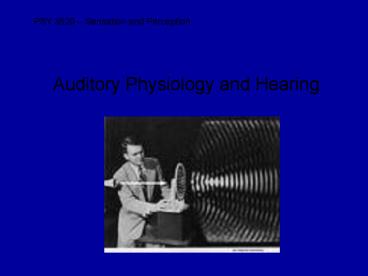Auditory Physiology and Hearing - PowerPoint PPT Presentation
1 / 23
Title:
Auditory Physiology and Hearing
Description:
Auditory Physiology and Hearing. PSY 3520 Sensation and Perception. Auditory Physiology & Hearing ... not maintained as move up through the auditory pathway ... – PowerPoint PPT presentation
Number of Views:1683
Avg rating:3.0/5.0
Title: Auditory Physiology and Hearing
1
PSY 3520 Sensation and Perception
Auditory Physiology and Hearing
2
Auditory Physiology HearingLecture Outline
- I. The Stimulus for Hearing
- A. Pure Tones
- 1. Amplitude
- 2. Frequency
- B. Perceptual Dimensions of Sound
- C. Complex Sounds and Fourier Analysis
- II. Structure and Functioning of the Auditory
System - A. Outer Ear
- 1. Pinnae
- 2. Auditory Canal (External Auditory Meatus)
- 3. Tympanic Membrane (Eardrum)
- B. Middle Ear
- 1. Ossicles (Malleus/Hammer, Incus/Anvil,
Stapes/Stirrup) - 2. Function of the Ossicles
- 3. Eustachian Tube
- C. Inner Ear
- 1. Cochlear Compartments
- 2. Organ of Corti
- 3. Transduction What causes a hair cell to
bend?
3
Auditory Physiology HearingLecture Outline
- III. The Code for Frequency
- A. Place Code
- B. Frequency (Timing) Code
- C. Pitch and Loudness Perception Place vs.
Frequency Theory - IV. Place and Timing Information in the Central
Auditory System - A. Auditory Pathways
- B. Place Information
- C. Timing Information
- V. Physiology of Sound Localization
- A. Interaural Time Difference
- B. Interaural Intensity
- VI. The Audibility Curve
4
Inner Ear
- Main structure of the inner ear is the
_______________
5
Cochlea
- Three compartments
- _________________________
- _________________________
- _________________________
- Cochlear duct
- formed by 2 membranes
- _____________________
- _____________________
- cochlea functioning
6
Organ of Corti
- The primary auditory receptor structure (15,000
hair cells)
7
Transduction
- Transduction occurs in the ____________ housed in
the _______________ - What causes stereocilia of a hair cell to bend?
- Footplate of the stapes pushes the oval window
- Causes motion in the cochlear fluid
- Tectorial membrane
8
Hair Cells
- There are two types of hair cells
- _____________
- _____________
9
Hair Cells
10
Auditory Nerve Fibers
11
Review
- Auditory Perceptual Process
12
The Code for Frequency
- Two major theories
- ________________
- _________________
Bekesy
13
Place Code Theory
- Georg von Bekesy (1920s) vibration of the
basilar membrane
14
Place Code Theory
- Bekesy (1960s) properties of the envelope of
the traveling wave - Envelope is peaked at ____ point on the basilar
membrane - Position of the peak is a function of the
________ of sound
15
Place Code Theory
- Further support
- Culler et al. (1943) cochlear responses
- Russell Sellick (1977) hair cell tuning
- Kiang (1975) auditory nerve fiber tuning
16
Timing Code for Frequency/Frequency Theory
- Rutherford (1886) neural firing rate
- Wever (1949) volley principle
- Rose et al. (1967) phase locking
- _____________ neurons fire in synchrony with
the phase of a stimulus
17
Pitch Perception
- Periodicity Pitch the missing fundamental
18
Physiological Aspects of Loudness
- How can nerve firing signal loudness?
- When intensity increases
- Neurons already firing saturate (above 40-50 dB
SPL) - Neurons at other places on basilar membrane begin
to fire more rapidly (pattern of auditory firing
becomes broader)
19
Central Auditory System
20
Place Information
- Place information is maintained through ________
mapping - Auditory cortex has
- ________ organization
- Place code mainly
- responsible for pitch
- perception
21
Timing Information
- Phase locking not maintained as move up through
the auditory pathway - When phase locking occurs it is for frequencies
below ________ Hz - Timing mechanism provides information about _____
frequency sounds
22
Physiology of Sound Localization
- ______________
- Interaural time difference detector
- ______________
- Neurons responding to certain locations in space
- Knudsen Konishi (178)
23
Audibility Curve































